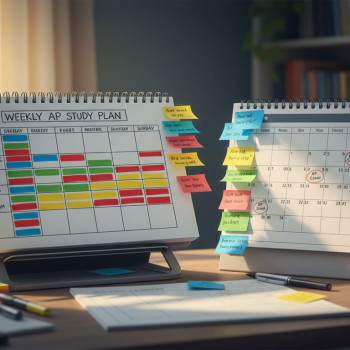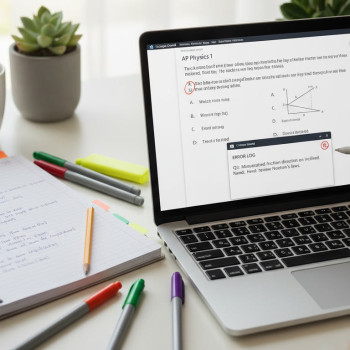Why Critique Etiquette Matters for AP Students
If you’re taking AP courses, you already know this: the road to a 4 or 5 is paved with practice, honest self-reflection, and—crucially—good feedback. Critique etiquette is the set of unspoken rules that makes feedback useful, respectful, and actionable. It’s what turns a vague comment into a breakthrough, a friendly nudge into a habit change, and a well-intentioned critique into measurable improvement.
This guide is written for students, peer reviewers, and tutors working with AP material. Whether you’re trading essays in AP English Language, reviewing lab reports in AP Biology, or practicing FRQs for AP US History, the same principles apply. You’ll get practical tactics for both giving and receiving feedback, examples that make the concepts concrete, and a ready-to-use checklist for your next study group or tutoring session.
Core Principles of Helpful Critique
Before we get tactical, let’s anchor in principles. These aren’t just niceties—they’re what distinguish feedback that helps you improve from feedback that confuses or demotivates.
- Specificity over vagueness: “Good job” is not feedback. “The thesis is clear but needs stronger evidence in paragraph three” is.
- Actionable suggestions: Feedback should be something the recipient can try immediately—rewrite a sentence, add a citation, restructure the argument.
- Respect the author’s intent: Don’t impose your style unless the assignment allows it. Ask what the author wanted to achieve.
- Balance praise with improvement: Start with what works, then identify what to change.
- Clarity about standards: Align on the rubric or AP scoring criteria first—otherwise you’re guessing what “good” means.
- Timeliness: Feedback is most useful when given quickly while the work and the decisions that produced it are still fresh.
Example: Turning Vague into Useful
Vague: “This paragraph is weak.”
Useful: “This paragraph lacks a clear topic sentence and a direct link to your thesis. Try starting with a topic sentence that names the claim, then add two pieces of textual evidence and a brief explanation of how the evidence supports the claim.”

How to Give Feedback: A Step-by-Step Approach
Giving feedback is a skill you can practice and refine. Use this step-by-step method the next time you review an essay, FRQ, lab report, or presentation.
1. Ask Before You Dive In
Start by asking the author what they want most from your critique. Are they worried about organization, evidence, clarity, or grammar? Setting this expectation prevents off-target comments and saves time.
2. Read or Listen Twice
First pass: get the big picture—purpose, thesis, and structure. Second pass: look for details—evidence, logic, and mechanics. This simple habit reduces knee-jerk reactions and yields thoughtful feedback.
3. Use the “Praise-Question-Suggestion” Frame
- Praise: Name one or two things the author did well. Be concrete (e.g., “Your opening anecdote grabbed me and tied to the thesis.”).
- Question: Ask clarifying questions that reveal gaps (e.g., “How does this example tie to your main claim?”).
- Suggestion: Offer a specific action (e.g., “Consider replacing this sentence with a clearer topic sentence that outlines your three points.”).
4. Prioritize Feedback
Don’t overwhelm. Pick 2–3 prioritized areas to work on. For AP essays, prioritize thesis clarity, evidence, and analysis over perfect grammar on a first pass.
5. Be Concrete and Show Examples
Instead of saying “make this stronger,” rewrite one sentence or show how you’d rework a paragraph. Examples teach more than rules.
6. Respect Tone and Timing
Feedback is most effective when the giver is calm and the receiver is ready. If the student looks frustrated or emotionally raw, offer to return to the critique later.
How to Receive Feedback Gracefully and Usefully
Receiving feedback well is a skill that separates passivity from improvement. When you learn to extract the signal from the noise, you turn critique into momentum.
1. Listen First, Defend Later
Resist the urge to explain or justify immediately. Note key points, ask clarifying questions, then reflect. Defensiveness hides learning.
2. Ask for Examples
If feedback is vague, ask the giver to point to a sentence or show a replacement. Examples make feedback practical.
3. Prioritize and Plan
Turn feedback into a short to-do list. For AP-style work, a practical plan might look like:
- Revise thesis to be specific and argumentative.
- Add two additional pieces of evidence in body paragraph two.
- Rewrite conclusion to synthesize rather than summarize.
4. Use a Fast Iteration Cycle
Make the suggested changes and ask for another quick read. Iteration builds skill and confidence—this is how writers and scientists improve rapidly.
5. Separate Praise from Evidence
People often include subjective opinions in feedback. Ask: “Is that observation tied to the rubric or the assignment’s goals?” If not, decide whether to apply it based on your intent.
Classroom and Peer-Review Scenarios — Practical Scripts
Scripts help when you’re new to critique. Below are short, practical lines you can use.
- Giving feedback: “I liked how you framed the problem. One area to strengthen is your second paragraph—could you add more evidence and tie it back to the thesis?”
- Receiving feedback: “Thanks—can you show me one sentence you think is unclear?”
- When confused: “I’m not sure I understand. Could you explain how this point affects my overall argument?”
- When overwhelmed: “This is a lot—could you help me prioritize the top two changes?”
Rubrics and Criteria: Aligning Expectations
One common source of conflict in peer feedback is mismatched expectations. If you’re preparing for an AP exam, align critiques with the official scoring guidelines. Even in class, use a simple rubric so feedback is anchored to objective standards.
| Criterion | What It Looks Like | Quick Fix |
|---|---|---|
| Thesis | Clear, argumentative, and referenced throughout the essay | Rewrite as a single sentence that states a claim and preview of reasons |
| Evidence | Relevant, specific, and well-integrated | Add quotes or data and link each piece to your claim |
| Analysis | Explains why evidence matters, not just what it is | Ask “So what?” after each piece of evidence and answer it |
| Organization | Logical flow, clear paragraph transitions | Use topic sentences and transition phrases |
| Mechanics | Grammar and syntax support clarity | Focus on mechanics last, after structure and content |
Handling Tough Feedback: When Critique Feels Personal
Sometimes feedback stings. That’s normal. The key is to separate your identity from your work. Your brain made something; it’s not you. Here are steps for processing harsh critique:
- Pause and breathe—reacting in the moment can escalate the emotion.
- Ask clarifying questions later in private: “I want to better understand—can you show me where to start?”
- Find one useful takeaway, even if the feedback felt unfair.
- If feedback is abusive or disrespectful, escalate to a teacher or moderator—critique should never be a vehicle for personal attack.
Peer-Review Workflow for Study Groups: A Template
Use this 45-minute workflow in a study group or tutoring session to ensure productive critique cycles.
- 0–5 min: State purpose—what each piece is being reviewed for (thesis clarity, evidence, timing for a speech, etc.).
- 5–15 min: Silent read/listen (annotators mark pages with 2–3 notes each).
- 15–30 min: Oral feedback round using Praise-Question-Suggestion frame (2–3 points per person).
- 30–40 min: Author asks clarifying questions and makes a quick plan.
- 40–45 min: Quick rework or follow-up assignment assigned (who does what and when).
Technology, Tutors, and AI: Tools to Make Critique Smarter
Technology can speed up feedback loops—but it doesn’t replace human judgment. Grammar checkers and AI editors help with mechanics; rubrics and shared documents streamline collaboration. For targeted growth, personalized tutoring can focus feedback on recurring patterns in your work.
For example, Sparkl’s personalized tutoring blends one-on-one guidance and tailored study plans with data-driven insights—so your tutor isn’t guessing. Over time, the tutor identifies recurring weaknesses (e.g., weak analysis or inconsistent evidence) and builds a plan to address them. This combination of human coaching and AI-driven patterns creates a feedback loop that is both kind and effective.
Examples: Before and After Edits
Seeing edits in action helps. Below are short before-and-after snippets illustrating how critiques translate to stronger responses.
AP English – Thesis and Topic Sentence
Before: “Many authors discuss freedom in their work.”
After: “In both Douglass’s narrative and Jacobs’s memoir, freedom is portrayed as a gradual acquisition of agency, achieved through literacy, strategic alliances, and individual resistance.”
Why it works: Specifics replace vagueness, and the after-thesis previews the essay’s structure.
AP History – Evidence and Analysis
Before: “The New Deal helped the economy.”
After: “The New Deal’s public-works programs, such as the WPA and CCC, reduced unemployment in the short term by providing jobs and stimulated local economies through increased public spending; however, unemployment rates did not return to pre-depression levels until wartime mobilization.”
Why it works: Adds specifics, evidence, and a nuanced analysis.
Measuring Progress: Keep a Feedback Log
Track recurring feedback in a simple log. Over a semester, patterns emerge and improvement becomes visible. Your log columns could be:
- Date
- Work Reviewed
- Top 3 Feedback Points
- Action Taken
- Follow-up Result
Example entry: 09/12 — AP Lang Draft; Top feedback: unclear thesis, weak evidence; Action: rewrite thesis and add two quotes; Result: peer reread marked thesis strong.
Common Mistakes and How to Avoid Them
- Too Many Comments: Overloading the author overwhelms. Avoid by limiting to top 3 issues.
- Fixing Style Without Consent: Don’t rewrite someone’s voice unless asked; suggest alternatives instead.
- Mixing Feedback Types: Blend subjective opinion with rubric-based critique—label each so the author knows which is which.
- Delaying Feedback: Late feedback is less useful—aim to provide it within a day or two for major assignments.
Final Checklist for a Productive Critique Session
Before you start either giving or receiving feedback, run through this quick checklist:
- Have we agreed on the assignment objectives or rubric?
- Did the author state what they want from reviewers?
- Are we limiting feedback to the top 3 priorities?
- Is feedback specific, actionable, and respectful?
- Do we have a short plan and a follow-up date?

Putting It All Together: From Feedback to Higher AP Scores
Good critique etiquette shortens the path to improvement. For AP students, that means clearer essays, stronger arguments, better lab reports, and more confident test performance. Combine peer review with short iteration cycles, use rubrics to align expectations, and consider targeted help when patterns persist.
Sparkl’s personalized tutoring can fit naturally into this process: tutors provide direct, rubric-aligned feedback, help you practice the same revision cycles, and deliver tailored study plans focused on your recurring weaknesses. When tutoring complements peer critique and self-reflection, you get faster, more reliable progress.
Parting Advice: Critique as a Growth Habit
Make critique etiquette a habit. Schedule regular feedback sessions, treat revisions as experiments, and celebrate small wins. Over time you’ll not only get better grades—you’ll develop a thoughtful, resilient approach to learning that serves you far beyond AP exams.
Quick Reminder
Feedback is a two-way street: give it with care, receive it with curiosity, and act on it with purpose. That’s how good students become great thinkers.
Ready to practice? Start a short peer-review session today: set a 45-minute timer, pick one essay or FRQ, and use the Praise-Question-Suggestion frame. You’ll be surprised how much progress you can make in under an hour.




















No Comments
Leave a comment Cancel